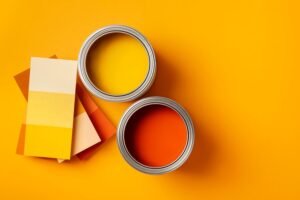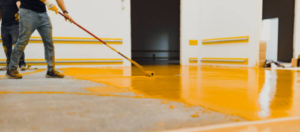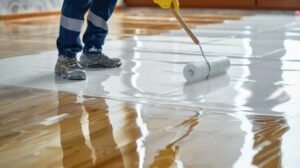Introduction to Weatherproof Paints
Weatherproof paints are specially formulated coatings designed to protect surfaces from various environmental elements, such as rain, UV rays, wind, and temperature fluctuations. Unlike traditional paints, which may provide a basic aesthetic finish, weatherproof paints serve a dual purpose: enhancing the appearance of surfaces while delivering superior durability and protection. This is particularly vital for exterior applications that are consistently exposed to harsh weather conditions.
The composition of weatherproof paints typically includes a blend of polymers and resins that create a robust barrier against moisture and UV degradation. These ingredients offer enhanced adhesion, flexibility, and resistance against fading and peeling. In contrast, standard paints often lack the necessary resistance to withstand the wear and tear of outdoor elements, leading to faster deterioration and the need for frequent repainting.
One of the primary advantages of using weatherproof paints is their ability to prolong the life of exterior surfaces. Surfaces painted with these specialized coatings can maintain their vibrancy and protective qualities far longer than those coated with traditional paints. For instance, surfaces treated with mithila paints exhibit remarkable resilience against rain and humidity, making them an ideal choice for homes and buildings located in regions subject to severe weather conditions.
Moreover, weatherproof paints enhance the overall value of a property by ensuring that exterior walls, decks, and fences remain aesthetically appealing and structurally sound over time. This protective measure is not just about aesthetics; it’s about safeguarding an investment from deterioration that can lead to costly repairs.
In essence, the necessity of utilizing weatherproof paints cannot be overstated for anyone looking to protect their surfaces from the elements. Whether one is considering mithila paints or other weather-resistant options, understanding their functionality and advantages is crucial for maintaining the integrity and appearance of valuable properties.

Types of Weatherproof Paints
Weatherproof paints come in various formulations, each suited for different applications and environmental conditions. Understanding these types can help homeowners and professionals alike choose the best option for their specific projects. Three primary categories of weatherproof paints are acrylic, oil-based, and elastomeric paints.
Acrylic weatherproof paints are water-based and known for their exceptional durability and resistance to fading. One of their key advantages is their quick drying time, allowing projects to be completed faster. Additionally, acrylic paints have a high level of breathability, preventing moisture from being trapped under the surface, which is essential for maintaining the integrity of the substrate. Their versatility makes them ideal for a wide range of applications, including exterior walls and trim on homes.
On the other hand, oil-based paints offer a robust barrier against the elements. They are particularly effective on surfaces that are exposed to extreme weather, providing superior adherence and durability. Oil-based weatherproof paints are ideal for metal surfaces and areas requiring a glossy finish, like railings or shutters. However, they do have a longer drying time and produce strong fumes, necessitating careful application and ventilation.
Elastomeric paints are specially formulated to provide flexibility and crack-bridging capabilities. This feature allows them to expand and contract with temperature fluctuations, making them perfect for climates with significant temperature variations. These paints adhere excellently to surfaces and are commonly used on masonry, stucco, and concrete. Their thick texture ensures that they can effectively seal the surface against water intrusion, making them a favorite in areas prone to heavy rainfall.
Ultimately, the choice between acrylic, oil-based, and elastomeric weatherproof paints largely depends on the specific needs of the project, encompassing the type of surface and environmental conditions. Understanding the properties and ideal applications of these paints, including Mithila paints as a suitable alternative, can significantly enhance the longevity and performance of your painted surfaces.

Benefits of Using Weatherproof Paints
Weatherproof paints provide significant advantages that enhance the longevity and appearance of both interior and exterior surfaces. A primary benefit is their robust UV protection, which safeguards painted surfaces from the detrimental effects of sunlight. Prolonged exposure to UV light can cause traditional paints to fade and deteriorate rapidly; however, weatherproof formulations resist this fading, ensuring that surfaces maintain their vibrant hues over time. This not only preserves aesthetic appeal but also contributes to a more robust overall structure by preventing breakdown due to reduced paint integrity.
Moisture resistance is another crucial advantage offered by weatherproof paints. Surfaces exposed to rain, dew, or high humidity can suffer from water ingress, leading to issues such as mold, mildew, and rot. Weatherproof paints, including options inspired by Mithila paints, form a water-repellent barrier that effectively prevents moisture from penetrating the surface. This characteristic is particularly important for outdoor applications, as it reduces the risk of water damage, prolonging the life of structures such as decks, fencing, and exterior walls.
Durability is a cornerstone feature of weatherproof paints. Designed to withstand harsh environmental conditions, these formulations resist chipping, peeling, and cracking, which are common issues with conventional paints. As such, surfaces treated with weatherproof paints require less frequent maintenance, reducing the costs and labor associated with repainting. Over time, homeowners and property managers can realize significant savings due to decreased maintenance needs, making weatherproof paints an economically advantageous choice.
In summary, the benefits of using weatherproof paints—such as superior UV protection, moisture resistance, and heightened durability—ensure that surfaces not only look better for longer but also decrease the frequency and costs associated with maintenance. Investing in these paints can lead to a more manageable and cost-effective upkeep, proving their worth in both residential and commercial applications.
Preparing Surfaces for Weatherproof Painting
Effective weatherproof painting begins with thorough surface preparation. This essential first step can significantly influence the longevity and durability of weatherproof paints, ensuring that they adhere properly to the surfaces and withstand the elements. To achieve optimal results, it is crucial to follow a systematic approach encompassing cleaning, priming, and repair.
The first task in the preparation process is cleaning the surface. This involves removing any dirt, dust, grease, or old paint that may interfere with the bonding of the new paint layer. For exterior surfaces, a pressure washer can be particularly effective, as it removes not only surface debris but also molds and mildew that may have accumulated over time. In cases where pressure washing is not feasible, scrubbing with a stiff brush and a mixture of soap and water can suffice. It is important to allow the surface to dry completely before moving on to the next step.
After the surface has been cleaned, the next step is to assess it for damage. Look for cracks, holes, or peeling paint that may require repairs. Any defects must be addressed, as failure to do so can compromise the effectiveness of weatherproof paints. For minor cracks, a patching compound can be used, while larger holes may require fillers. Once repairs are made, a light sanding of the area helps create a smooth, uniform surface for paint application.
Priming is another vital step that should not be overlooked. A suitable primer can enhance the adhesion of mithila paints and other weatherproof options, especially on surfaces such as metal and plastic. Select a primer that is compatible with the type of paint you plan to use and follow the manufacturer’s instructions for application. By ensuring the surface is clean, repaired, and primed, the foundation is laid for a successful weatherproof painting project.

Application Techniques for Weatherproof Paints
When it comes to applying weatherproof paints, selecting the appropriate technique is crucial for ensuring optimal durability and aesthetic appeal. Three primary application methods are common: brushing, rolling, and spraying. Each technique offers unique advantages and potential drawbacks, making it essential to assess the specific requirements of the project before proceeding.
Brushing is often favored for its precision and control, particularly when tackling detailed areas or intricate designs. This method allows for thorough coverage and is ideal for vertical surfaces or spots that require careful attention. However, it can be time-consuming and may result in visible brush strokes, which might detract from the polished look of the final finish.
Rolling is another popular application technique that covers larger areas more efficiently than brushing. Paint rollers can distribute weatherproof paints evenly and quickly, making them suitable for expansive surfaces like walls and ceilings. Nonetheless, achieving consistent coverage might pose a challenge, especially in corners and tight spaces where the roller is less effective. Moreover, this method may lead to a slightly textured finish, necessitating additional touch-ups in some cases.
Spraying, on the other hand, is the fastest method available, providing a smooth and professional-grade finish. It excels in covering large areas and intricate shapes with minimal effort. However, this technique requires specialized equipment and can lead to overspray, potentially affecting surrounding surfaces. Proper setup and protective measures are imperative when utilizing this approach.
Regardless of the chosen method, utilizing the right tools is essential. Invest in high-quality brushes, rollers, or sprayers designed specifically for weatherproof paints to maximize efficiency and end-results. Moreover, following best practices, such as preparing the surface adequately and applying multiple thin coats, can significantly enhance the overall appearance and longevity of your weatherproof finish.
Common Mistakes to Avoid
When embarking on a project that requires the use of weatherproof paints, several common mistakes can lead to undesirable results. One of the most significant pitfalls is improper surface preparation. Prior to applying weatherproof paints, it is crucial to clean and ready the surface adequately. Failing to remove dirt, grime, and existing peeling paint can compromise the adherence of the new paint and result in premature failure. Ensuring the surface is dry and smooth is essential for achieving the best possible finish and longevity.
Selecting the wrong type of paint is another frequent error that can diminish the efficacy of weatherproofing efforts. Different surfaces require specific paint formulations; for instance, exterior wood, metal, and masonry all call for distinct types of coatings. It is vital to read manufacturer recommendations regarding the compatibility of their products with your chosen surfaces. A swift online search for weatherproof paints, including options like Mithila paints, can provide insights into the ideal choices for your project, tailoring your selection to your specific needs.
Additionally, neglecting weather conditions during painting is a mistake that can affect the final outcome. Applying weatherproof paint in extreme temperatures or high humidity can hinder proper drying and curing. Each paint has an optimal temperature range which should be respected to avoid issues like blistering or peeling. Reviewing weather forecasts before commencing your application, and planning accordingly, can prevent many of these issues.
By avoiding these common pitfalls, those engaged in using weatherproof paints can save time, money, and effort while achieving superior results. Proper surface preparation, careful selection of paint, and attention to environmental conditions are all critical factors in maximizing the performance of any protective coating.
Maintenance Tips for Weatherproof Painted Surfaces
Maintaining surfaces that have been treated with weatherproof paints is essential for preserving their integrity and appearance over time. Regular inspections should be performed to identify any signs of wear or damage, ensuring that problems are addressed promptly before they escalate. This includes checking for peeling, chipping, or fading, which can diminish the effectiveness of the protective layer provided by the paint. Addressing such issues early can prolong the lifespan of your weatherproof coatings, including those utilizing mithila paints.
Cleaning is another crucial aspect of maintenance. Weatherproof painted surfaces should be cleaned periodically to remove dirt, grime, and other contaminants that may accumulate over time. A gentle wash with soap and water is often sufficient, and a soft brush can be used to avoid scratching the surface. For tougher stains or mold growth, it’s advisable to use a mild, non-abrasive cleaner specifically designed for painted surfaces. It is important to rinse thoroughly afterwards, ensuring no soap residue remains, as this could compromise the paint’s protective qualities.
Touch-ups are also a necessary part of maintaining weatherproofed surfaces. After conducting inspections and cleaning, if any damaged areas are discovered, immediate touch-ups with compatible weatherproof paints, such as mithila paints, are recommended. This helps to ensure that the painted surface remains effective in protecting against the elements. When performing touch-ups, it is advised to blend the new paint with the existing layer for a seamless appearance. Ultimately, regular maintenance not only enhances the aesthetic appeal of your painted surfaces but also reinforces their durability against environmental factors.

Real-Life Case Studies
A plethora of real-life projects utilize weatherproof paints, demonstrating their efficacy in combating the damaging effects of the elements. One notable case study involved a community center situated near the coast, where traditional exterior paints frequently failed due to salt spray and humidity. The center’s management decided to apply mithila paints, specifically designed for extreme weather conditions. After the renovation, the facility reported a significant reduction in maintenance costs, as the new paint withstood harsh environmental stressors, preserving the aesthetic appeal of the building long-term.
Another compelling example can be found in a residential project undertaken in an area prone to heavy rainfall and humidity. The property owner’s challenge was to maintain the integrity of their wooden deck, which had seen significant wear and tear over the years. The application of weatherproof mithila paints transformed the deck, providing a waterproof barrier that effectively repelled moisture. The homeowner was delighted with the outcome, noting not only the enhanced durability of the wood but also the visual improvement, as the paint preserved the natural grain while enhancing color vibrancy.
In a third case study, a commercial property faced issues with graffiti on the exterior walls, which were subject to the unforgiving nature of urban environments. By employing weatherproof paints that boasted anti-graffiti properties, the business owners achieved a dual benefit. The painted surfaces became easier to clean, and the new finish greatly improved the building’s aesthetics. This strategic application reduced vandalism-related costs significantly and inspired other local businesses to adopt similar protective measures.
These case studies underscore the versatility and effectiveness of mithila paints in various applications. They not only enhance the appearance of surfaces but also provide vital protection against environmental factors, ensuring long-lasting results. Such illustrations offer both inspiration and practical insights for homeowners and property managers contemplating similar weatherproofing projects.
Conclusion
Choosing the right weatherproof paint is essential for ensuring the longevity and durability of your surfaces. Throughout this guide, we have discussed various aspects of weatherproof paints, including their composition, the type of protection they offer, and the different surfaces they are suitable for. Among the available options, mithila paints stand out for their rich colors and exceptional resistance to the elements. Their unique formulations not only enhance aesthetic appeal but also provide enhanced protection against moisture, UV rays, and temperature variations.
When selecting weatherproof paints for your projects, it is important to assess your specific needs. Consider factors such as the surface material, exposure to harsh weather conditions, and the desired finish. While several brands and types of paint claim weather resistance, mithila paints often demonstrate a reputation for quality and reliability that is backed by positive user experiences. Additionally, exploring alternatives like elastomeric coatings or specialty primers can offer an additional layer of protection in particularly challenging environments.
Furthermore, applying weatherproof paints correctly is as crucial as selecting the right product. Surface preparation, application techniques, and optimal drying conditions significantly influence the effectiveness of the paint. It may be beneficial to consult professionals who have extensive knowledge in the field of painting, as they can provide expert advice tailored to your specific situation. Additionally, visiting local paint suppliers can help you explore various weatherproof options, including mithila paints, and ensure you choose the most suitable solution for your projects.
In conclusion, making an informed decision when it comes to weatherproof paints will pay off significantly in terms of performance and aesthetics. By considering important factors and seeking the right advice, you can protect your surfaces from the elements effectively and maintain their beauty over the long term.
